Canada 1993 "Prehistoric Life in Canada III, The Age of Dinosaurs"
| <prev | back to index | next> |
| Issue Date | 01.10.1993 |
| ID | Michel: 1389-1392, Scott: 1495-1498, Stanley Gibbons: 1570-1573, Yvert et Tellier: 1388-1391, Category: pR |
| Design | Design: Rolf P. Harder, Bernie Reilander |
| Stamps in set | 4 |
| Value | 43- Albertosaurus, dinosaur from Cretaceous Period 43- Platecarpus, marine Reptile form Cretaceous Period 43- Massospondylus, dinosaur from Jurassic Period 43- Styracosaurus, dinosaur from Cretaceous Period |
| Emission/Type | commemorative |
| Places of issue | Drumheller, AB |
| Size (width x height) | 44mm x 33mm |
| Layout | Stamps-Sheet of 20 |
| Products | FDC x1 |
| Paper | Harrison Paper (HP) with fluorescent frame (GT4), no watermark |
| Perforation | 13.5 x 13.5 |
| Print Technique | Offset lithography |
| Printed by | Ashton-Potter Limited |
| Quantity | 4,250,000 each |
| Issuing Authority | Canadian Post |
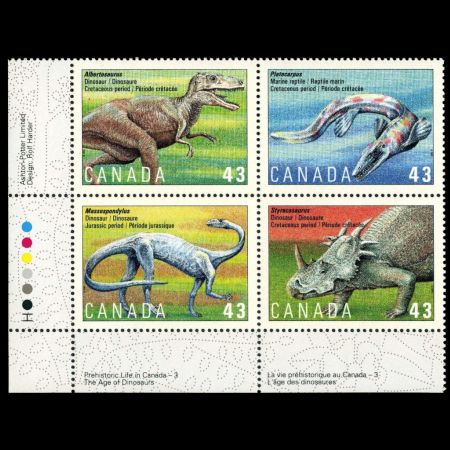
On October 1st 1993, Canadian Post issued the set "Prehistoric Life in Canada III, The Age of Dinosaurs" - the third four stamps in a four-year series on "Prehistoric Life in Canada". The series is chronological and covers an interval of time from 1900 million to 10,000 years ago.
The earlier sets were denominated at 39 cents (1990) and 40 cents (1991). The 1993 set was denominated at 43 cents per stamp.
The first four stamps in this series were issued as 39-cent denominations on July 12, 1990.
A key element in the design is the rendition of the texture of the creature's surface, which is produced by a mezzotint stipple effect. Although the colour of these beasts is subject to speculation, each is shown of a hue appropriate to its surroundings.
1993 was the year of world premiere of the famous "Jurassic Park" movie. On June 11, 1993, the film was released in the US, then in the rest of the world. The was the first time when the general public could see very realistic reconstructions of dinosaurs and other prehistoric reptiles. As result of a big success of the "Jurassic Park" movie, people everywhere were re-discovering a fascination with the "Age of Reptiles", a period in which the dinosaur was the dominant land creature.
Canada Post Corporation contributed to this phenomena with its issue of four stamps featuring three dinosaurs and one marine reptile. The same day, two other commonwealth countries, Australia and New Zealand issued their stamp sets with dinosaurs and other prehistoric lizards indigenous to their country.
The dinosaurs had 165 million years of domination of the earth from approximately 230 million to 65 million years ago. One theory of why the great beasts became extinct is because they could not adjust to drastic climatic changes brought about by a giant asteroid striking the Earth. Remains of dinosaurs have been found on all continents, with the first Canadian discovery being made at Morgan Creek, Saskatchewan in 1874 by geologists of Her Majesty's North American Boundary Commission. The famous "badlands" of Alberta yielded the most dinosaur finds in Canada to date. The choice of subjects was made on the advice of Canadian paleontologists and reflects importance, location in Canada, and visual suitability for depiction on stamps.
- Massospondylus - lived during the Jurassic period 205 million years ago and is the only known dinosaur to have lived in eastern Canada, in the Bay of Fundy area in Nova Scotia. Adults were between three to five meters in length, weighed about 200 kilograms and were herbivores feeding off foliage while standing on their powerful hind legs. When these small dinosaurs roamed the Bay of Fundy area, the landscape was much different than today's and there was one gigantic super continent "Pangea". The climate was semi-arid, sand dunes covered the valleys, and the Atlantic Ocean had not yet been formed.
-
The Albertosaurus were Cretaceous-period flesh-eating
dinosaurs belonging to the family Tyrannosauridae.
Slightly smaller than their better known cousin, the Tyrannosaurus, they were powerful
beasts which probably tore huge pieces of flesh from their living prey.
These dinosaurs had large heads, wart-like bony growths on the bridge of the nose, long teeth, and
foot claws which were more hoof-like than sickle-shaped.
They weighed approximately two and a half metric tonnes with a length of about 10 meters.
They inhabited the flood plains and deltas which separated the Rocky Mountains from the coastline of
the interior seaway to the east and existed between 83 and 65 million years ago.
The first fossil (skull) of Albertosaurus was discovered by Canadian geologist, cartographer, and mining consultant Joseph Burr Tyrrell in August 1884, near Drumheller. - The third and heaviest dinosaur in this stamp set, the Cretaceous-period Styracosaurus, is generally known for its rhino-like horn and the unusually long spines in its frill. A huge creature, midway in size between a bull hippo and a bull elephant, it weighed about 4 metric tonnes and measured 5 meters in length. Males and females had different spines, and the Styracosaurus featured on the stamp displays the long backward pointing spines believed to denote a male specimen. Females, it is thought, had spines curving forward. Specimens of this dinosaur have been found in Alberta and Montana where they roamed about 76 million years ago. The Alberta species differs from that found in Montana in that it has a greater number of frill spines.
- Platecarpus was a six-meter long Cretaceous-period marine reptile which represents something of a cross between a lizard and a seal. The most common of the mosasaurs, Platecarpus descended from land lizards and had limbs that were modified into paddle-like flippers, with a vertically expanded, eel-like tail. Savage and pugnacious in nature, they fed on fish and were in turn attacked by sharks. Platecarpus inhabited the North American mid-continental seaway, which 85 million years ago extended from Texas to the Arctic Ocean. In Canada, remains of Platecarpus have been discovered in the District of Mackenzie, Northwest Territories and near Morden, Manitoba. They have also been identified from Alabama to Europe to southern Africa. The group to which it belonged, mosasaurus, became extinct at the about same time as dinosaurs vanished from the face of the Earth.
Products and associated philatelic items
| FDC | Stamps Sheet | |
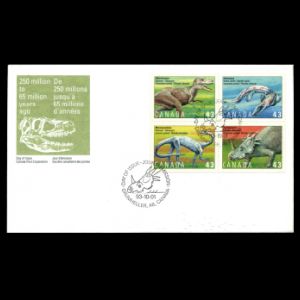 |
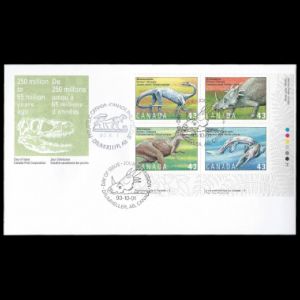 |
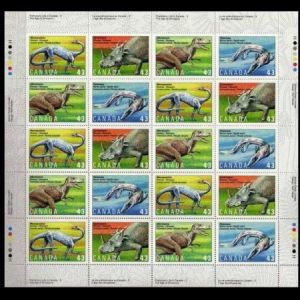 |
| The reverse side is here | The same FDC, but with an extra mark (probably not postal) of Drumheller | |
| First-Day-of-Issue Postmark | Example of circulated covers | |
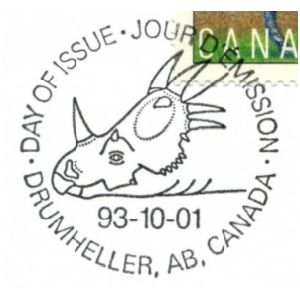 |
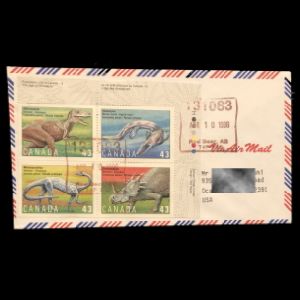 |
 |
References:

|
- Technical details and description of the stamps:
The Postage Stamp Press Release of Canada Post Corporation, reverse side of an FDC, colnect. "Canada's Dinosaur Stamps and Their Artist" by Susan Robinson, published in "Rock & Minerals" magazine, Volume 69, Issue 2, 1994. - Albertosaurus: Wikipedia
- Platecarpus: Wikipedia
- Massospondylus: Wikipedia
- Styracosaurus: Styracosaurus
- Cretaceous Period: Wikipedia
- Jurassic Period: Wikipedia
Acknowledgements:
Many thanks to Dr. Peter Voice, PhD Department of Geological and Environmental Sciences, Western Michigan University, USA, for his help in finding information and for review of a draft of this article.
| <prev | back to index | next> |